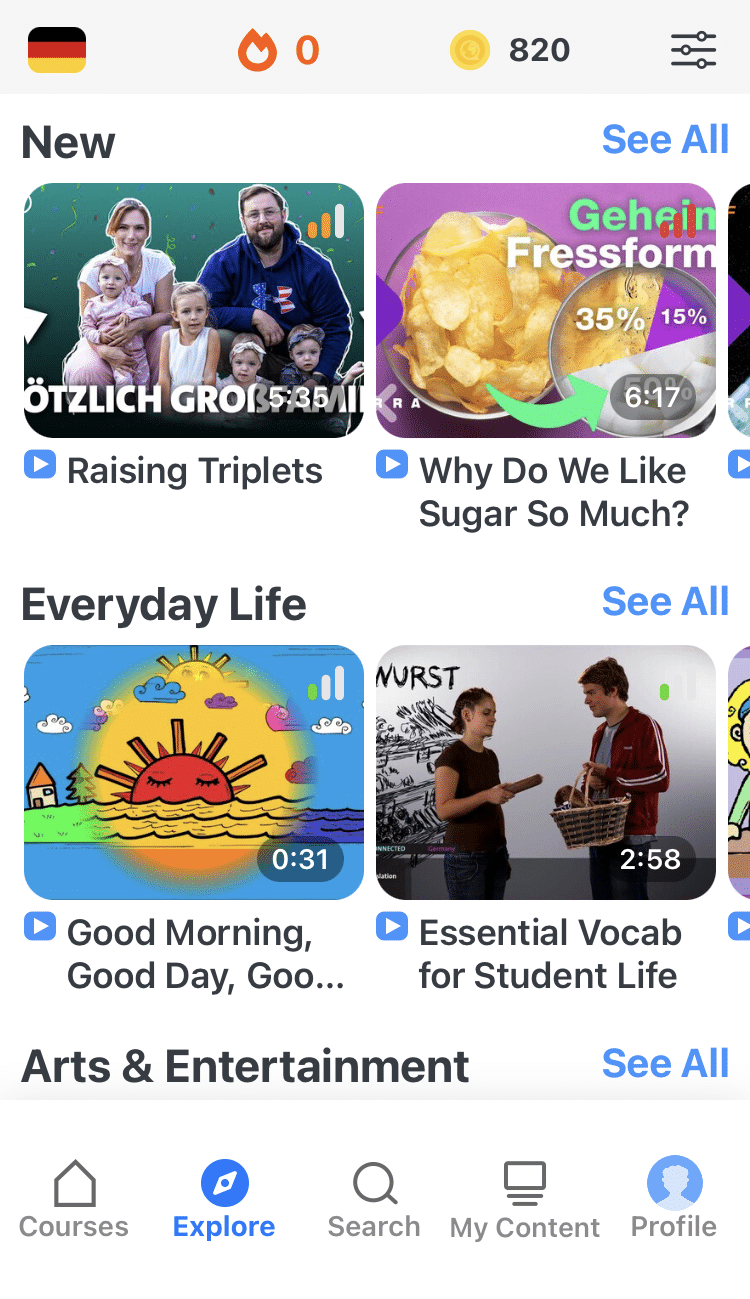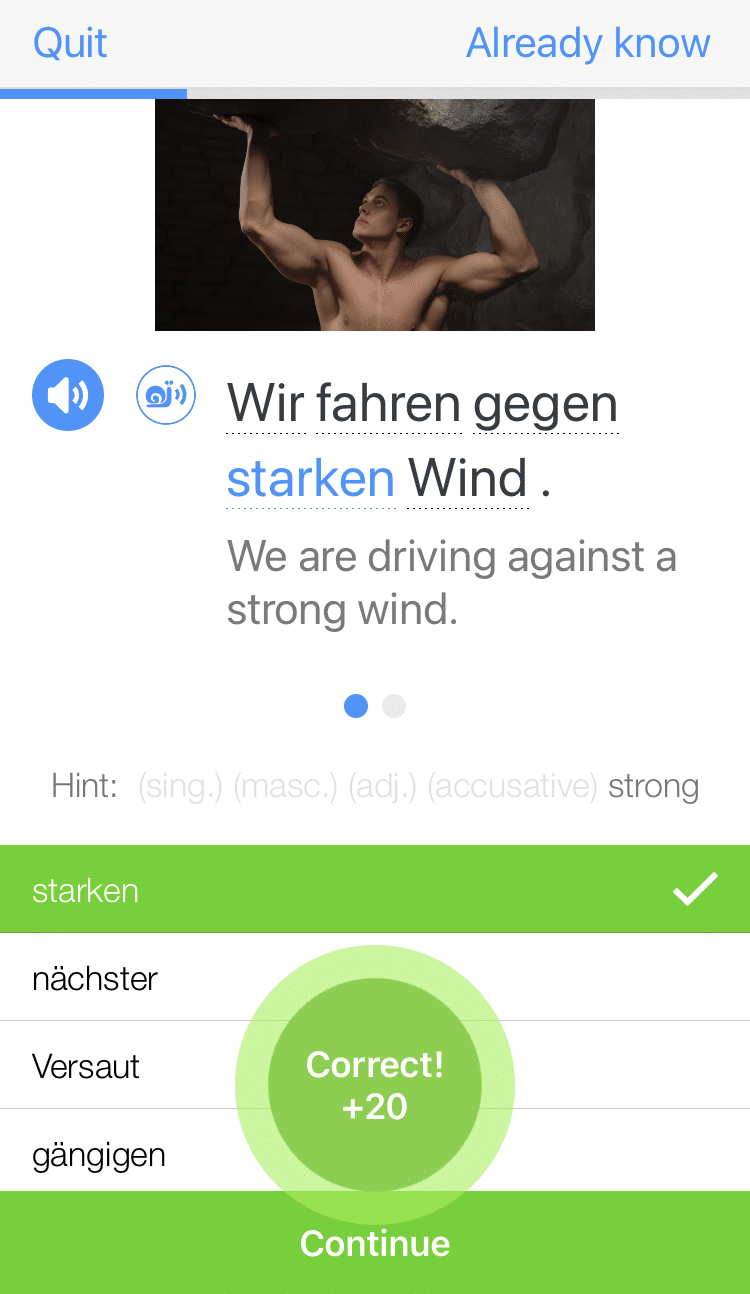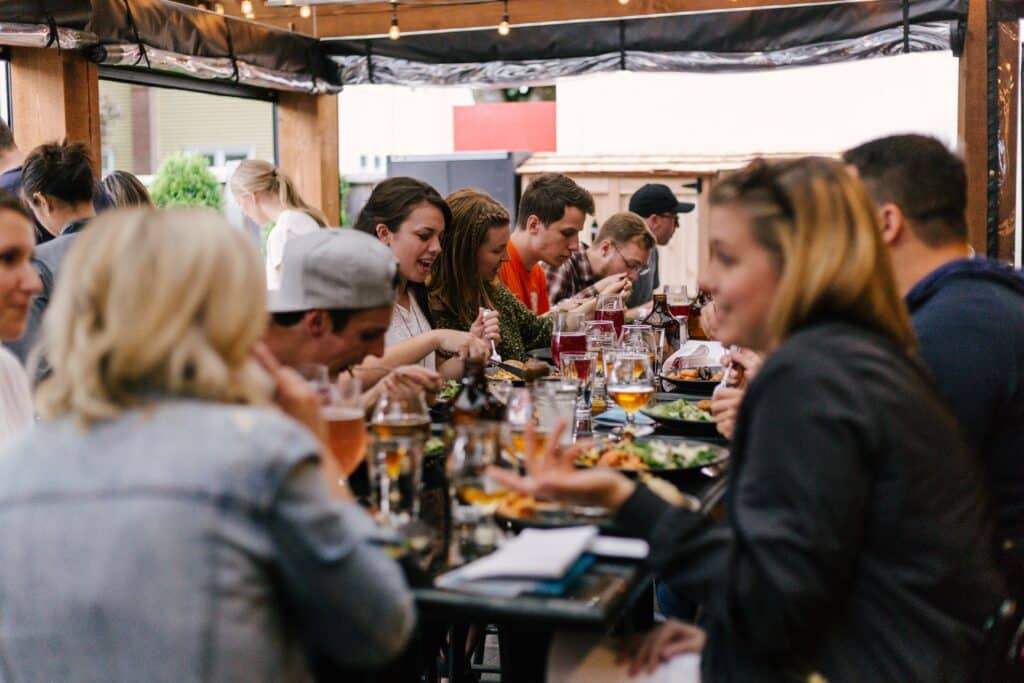
Food in German: 150 Essential Vocabulary Words
If you want to improve your German language skills and your understanding of Germany itself, then it’s time to sit down with a knife and fork.
This post will introduce you to more than 150 important German food vocabulary words for your shopping, cooking and dining needs.
We’ll cover all types of food, dishes and ingredients, and we’ll also tell you how to order at a restaurant.
Contents
- German Food Vocabulary
- Typical German Products
- Traditional German Dishes
- Ordering Food in German
- Food Culture in Germany
- And One More Thing...
Download: This blog post is available as a convenient and portable PDF that you can take anywhere. Click here to get a copy. (Download)
German Food Vocabulary
Food and Meals
| English | German |
|---|---|
| Food | das Essen |
| Meal | die Mahlzeit |
| Breakfast | der Frühstück |
| Lunch | das Mittagessen |
| Dinner/Supper | das Abendessen |
| Snack | der Snack |
| Appetizer | die Vorspeise |
| Main Course | das Hauptgericht |
| Dessert | der Nachtisch |
| Groceries | die Lebensmittel |
| Foodstuff | die Nahrung |
| Food (for animals) | das Futter |
Fruit
| English | German |
|---|---|
| Apple | der Apfel |
| Banana | die Banane |
| Orange | die Orange |
| Strawberry | die Erdbeere |
| Grape | die Traube |
| Lemon | die Zitrone |
| Cherry | die Kirsche |
| Peach | der Pfirsich |
| Pear | die Birne |
| Mango | die Mango |
| Pineapple | die Ananas |
| Raspberry | die Himbeere |
| Blueberry | die Blaubeere |
| Watermelon | die Wassermelone |
| Kiwi | die Kiwi |
| Melon | die Melone |
| Pomegranate | der Granatapfel |
| Blackberry | die Himbeere |
| Plum | die Pflaume |
| Tangerine | die Mandarine |
| Fig | die Feige |
| Apricot | die Aprikose |
| Cranberry | die Cranberry |
| Lychee | die Litschi |
| Passion Fruit | die Passionsfrucht |
| Quince | die Quitte |
| Guava | die Guave |
| Avocado | die Avocado |
| Coconut | die Kokosnuss |
Vegetables
| English | German |
|---|---|
| Carrot | die Karotte |
| Zucchini | die Zucchini |
| Tomato | die Tomate |
| Cucumber | die Gurke |
| Bell Pepper | die Paprika |
| Potato | die Kartoffel |
| Spinach | der Spinat |
| Onion | die Zwiebel |
| Garlic | der Knoblauch |
| Eggplant | die Aubergine |
| Asparagus | der Spargel |
| Cauliflower | der Blumenkohl |
| Broccoli | der Brokkoli |
| Peas | die Erbsen |
| Corn | der Mais |
| Beetroot | die Rote Beete |
| Carrot | die Möhre |
| Mushroom | der Pilz |
| Celery | die Sellerie |
| Leek | der Lauch |
| Radish | das Radieschen |
| Fennel | der Fenchel |
| Pumpkin | der Kürbis |
| Sweet Potato | die Süßkartoffel |
| Brussels Sprouts | der Rosenkohl |
| Mushroom | der Champignon |
| Parsley | die Petersilie |
| Radish | der Rettich |
Meat
| English | German |
|---|---|
| Beef | das Rindfleisch |
| Pork | das Schweinefleisch |
| Chicken | das Hähnchen |
| Turkey | der Truthahn |
| Lamb | das Lamm |
| Veal | das Kalbfleisch |
| Sausage | die Wurst |
| Bacon | der Speck |
| Salami | die Salami |
| Ham | der Schinken |
| Liver | die Leber |
Seafood
| English | German |
|---|---|
| Shrimp | die Garnelen |
| Salmon | der Lachs |
| Cod | der Kabeljau |
| Tuna | der Thunfisch |
| Mussels | die Muscheln |
| Trout | die Forelle |
| Crab | der Krebs |
| Octopus | der Oktopus |
| Sardine | die Sardine |
| Herring | der Heringsfisch |
| Anchovy | die Anchovis |
| Lobster | der Hummer |
| Oyster | die Auster |
| Calamari | der Tintenfisch |
Dairy
| English | German |
|---|---|
| Milk | die Milch |
| Cheese | der Käse |
| Butter | die Butter |
| Yogurt | der Joghurt |
| Cream | die Sahne |
| Sour Cream | die Saure Sahne |
| Cottage Cheese | der Hüttenkäse |
Breads and Grains
| English | German |
|---|---|
| Bread | das Brot |
| Roll | das Brötchen |
| Rye Bread | das Roggenbrot |
| Whole Wheat Bread | das Vollkornbrot |
| White Bread | das Weißbrot |
| Multigrain Bread | das Mehrkornbrot |
| Bagel | der Bagel |
| Pretzel | die Brezel |
| Rice | der Reis |
| Wheat | der Weizen |
| Barley | die Gerste |
| Oats | der Hafer |
| Spelt | der Dinkel |
Condiments
| English | German |
|---|---|
| Salt | das Salz |
| Pepper | der Pfeffer |
| Ketchup | der/das Ketchup |
| Mustard | der Senf |
| Mayonnaise | die Mayonnaise |
| Vinegar | der Essig |
| Olive Oil | das Olivenöl |
| Honey | der Honig |
| Soy Sauce | die Sojasauce |
| Hot Sauce | die Scharfe Soße |
Desserts
| English | German |
|---|---|
| Cake | der Kuchen |
| Pastry | das Gebäck |
| Ice Cream | die Eiscreme |
| Chocolate | die Schokolade |
| Custard | die Vanillesoße |
| Fruit Salad | der Obstsalat |
| Apple Strudel | der Apfelstrudel |
| Black Forest Cake | die Schwarzwälder Kirschtorte |
| Cheesecake | der Käsekuchen |
Typical German Products
Typisch Deutsches Essen — Typical German foods
A small selection of foods that you’ll eat a lot when in Germany:
Das Schwarzbrot — Rye bread
German bread, typically of dark brown color and made with wholemeal rye flour. You’ll find a huge selection of Schwarzbrot in German bakeries and grocery stores.
Die Brezel — Pretzel
A type of baked bread product made from dough shaped into a twisted knot.
Der Leberkäse — Meatloaf
Also called Fleischkäse, this is a German meatloaf and common snack food in the south of Germany.
Der Quark — Quark
Quark is a type of fresh dairy product, somewhat similar to soft fresh cheese. It can be used for everything from cake recipes to dips and low-fat spreads.
Das Sauerkraut — Sauerkraut
Sauerkraut is cabbage that has been fermented by various lactic acid bacteria. In Germany, it’s a very common side dish.
Die Bratwurst — Bratwurst
A German sausage usually made from pork and often served with Sauerkraut.
Die Weißwurst — White sausage
A traditional white sausage from Bavaria, made from minced veal and pork back bacon.
Der Süße Senf — Sweet mustard
Sweet mustard that comes from the south of Germany and is very common with sausages.
Traditional German Dishes
These 10 dishes represent different parts of Germany and its culture—even its history.
Bratwurst
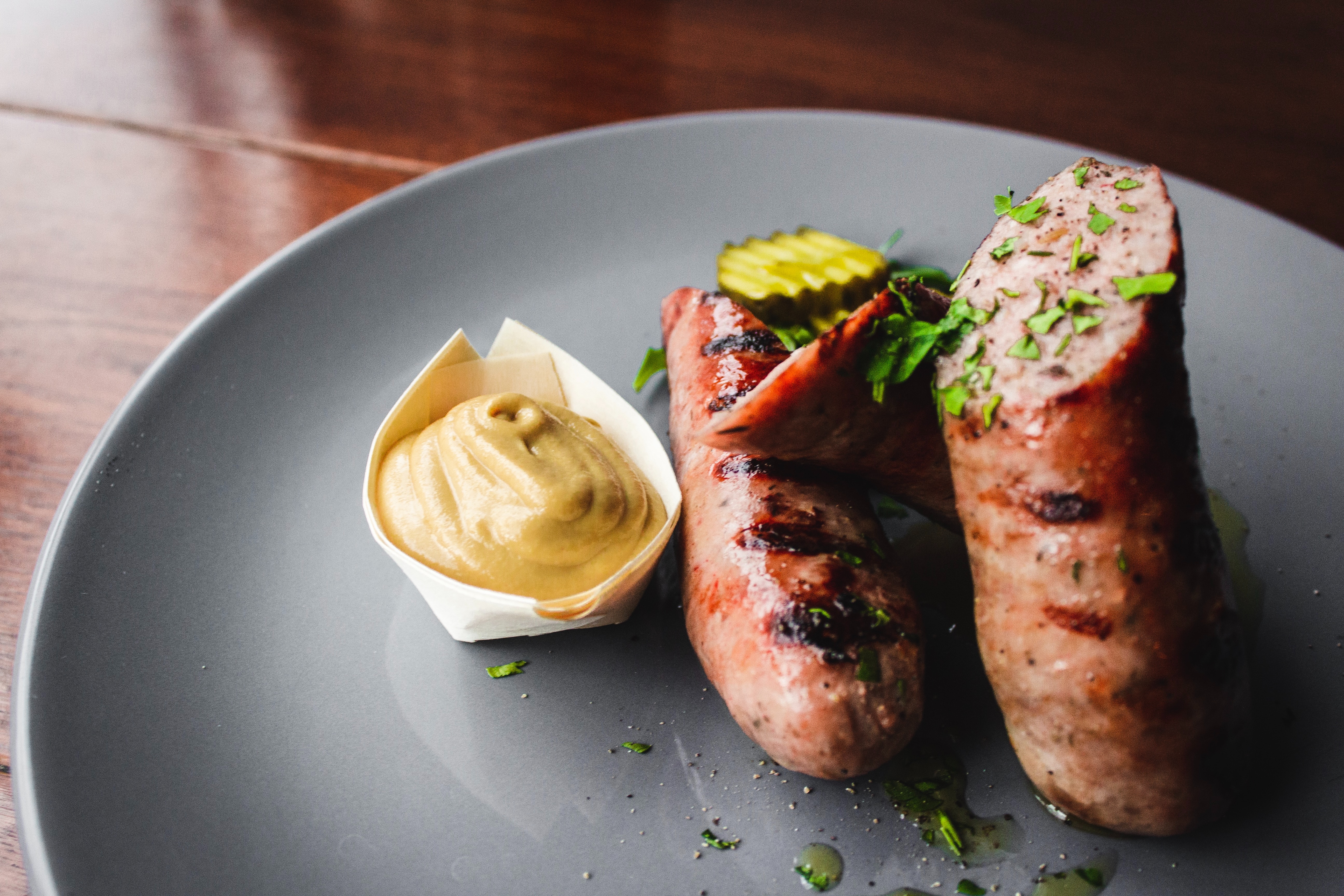
Since a number of American cities host mini-Oktoberfests in the fall, many of us are familiar with this classic. No matter where you go in Germany you are sure to encounter Bratwurst, a sausage usually made of beef, pork, or veal.
The earliest documented evidence of Bratwurst, which today has some 40 regional varieties, dates back to the 14th century in Nuremberg, a city still known for its production of sausages.
The way it is prepared is region-specific, usually grilled or fried and often served as a snack with a Brötchen (bread roll). Many Germans also enjoy eating Bratwurst with hot mustard.
If you’re from Wisconsin, a U.S. state where the largest ethnic group is German, you may be familiar with Bratwurst as it was brought and popularized there by German immigrants in the 1920s.
Sauerbraten
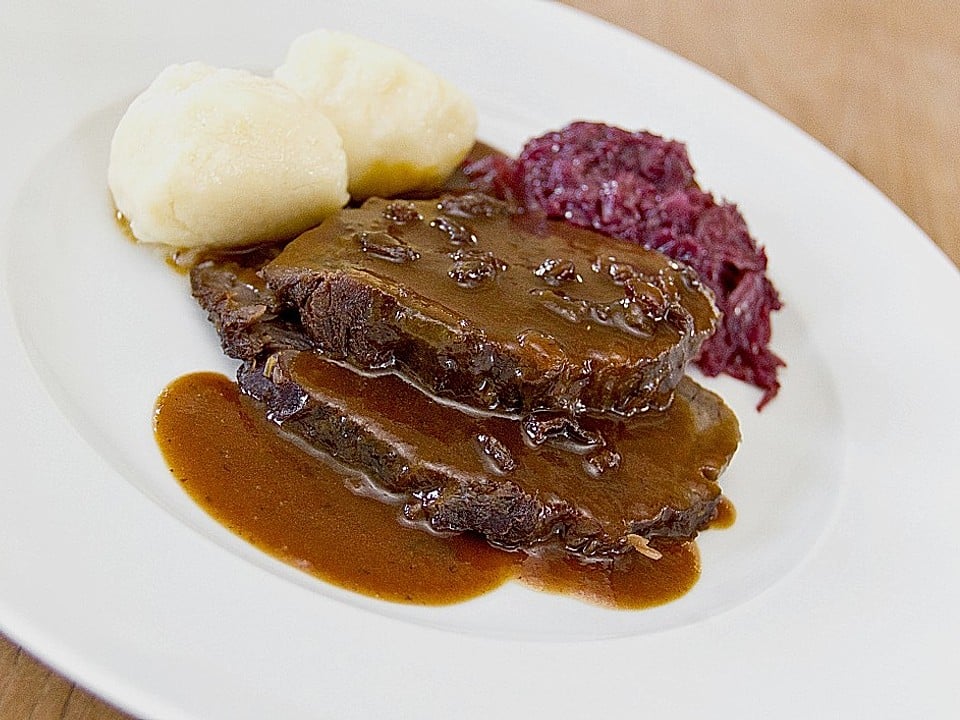
One of Germany’s best known dishes abroad, Sauerbraten is a pot roast that can be made with different meats (for example: beef, lamb, pork, horse, or venison) and is often served during the colder months of the year.
Before cooking this dish, the meat is marinated for days. While the ingredients of the marinade vary from region to region, it may consist of herbs, spices, vinegar, and red or white wine.
For example, regions of Germany that are closer to France tend to use red wine as the base. If you’re looking for a unique yet traditional dish for your holiday dinner, try your hand at Sauerbraten!
Spätzle
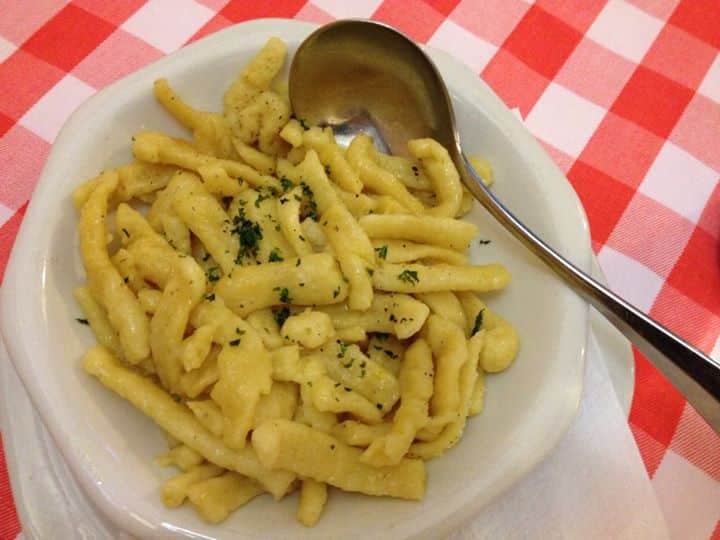
German cuisine is generally heavy on the meat. However, Spätzle, common in the south of Germany, is one of the few exceptions.
Spätzle is a kind of noodle or dumpling whose main ingredients are eggs, flour, and salt. It can be served alone as a main dish, as in Käsespätzle, which is served with grated Emmenthaler cheese and fried onions.
But most commonly, Spätzle accompanies a meat dish that usually has a rich gravy or sauce (like the aforementioned Sauerbraten).
Leberkäse
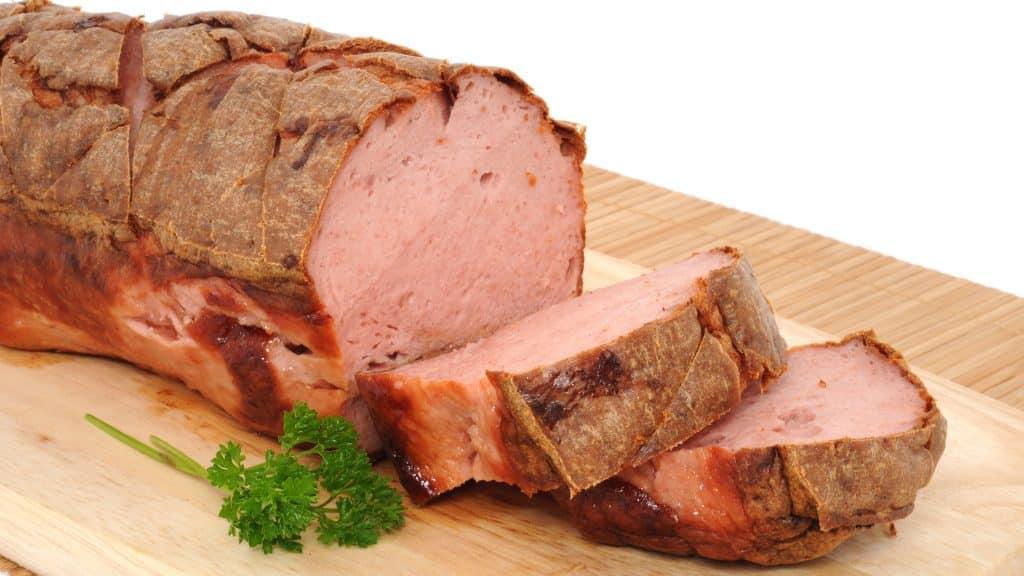
Literally “liver cheese,” Leberkäse is a pink meatloaf usually made of corned beef, but can also include pork and onions.
Popular in the south of Germany, it is made by grinding the meat and then baking it as a loaf until it has a brown crust. Leberkäse is usually served hot on a bread roll and can be eaten with mustard.
According to Germany’s food laws, a product advertised as Leberkäse must have a minimum liver content of 4% (unless it is Bavarian Leberkäse which does not have any liver).
If you’re ever in the south of Germany, make sure to give it a try! You may like it more than your mom’s meatloaf!
Maultaschen
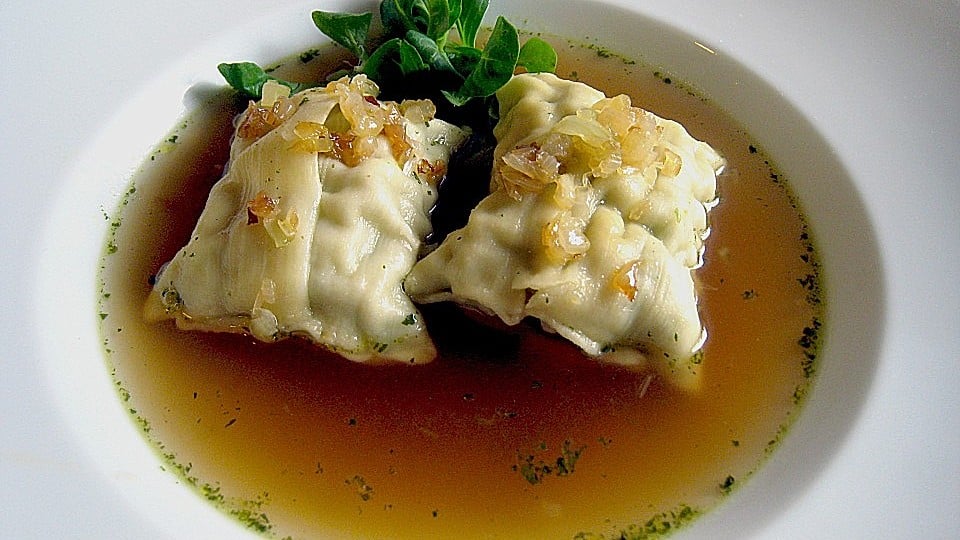
Maultaschen (mouth pockets/bags) originated in the German region of Swabia in the federal state of Baden-Württemberg and it is essentially a pasta dough dumpling that is traditionally filled with meat, eggs, onions, spinach, parsley and spices.
Similar to the Italian ravioli, Maultaschen are usually square or rectangular in shape. They can also be served in soup!
In 2009, the EU began protecting this Swabian specialty under the label of Schwäbische Maultaschen. The new law says that Maultaschen can only be made in Baden-Württemberg or in the historically Swabian district of Bavaria and that they must be made following specific guidelines. As you can see, food is a big part of one’s regional identity!
Currywurst
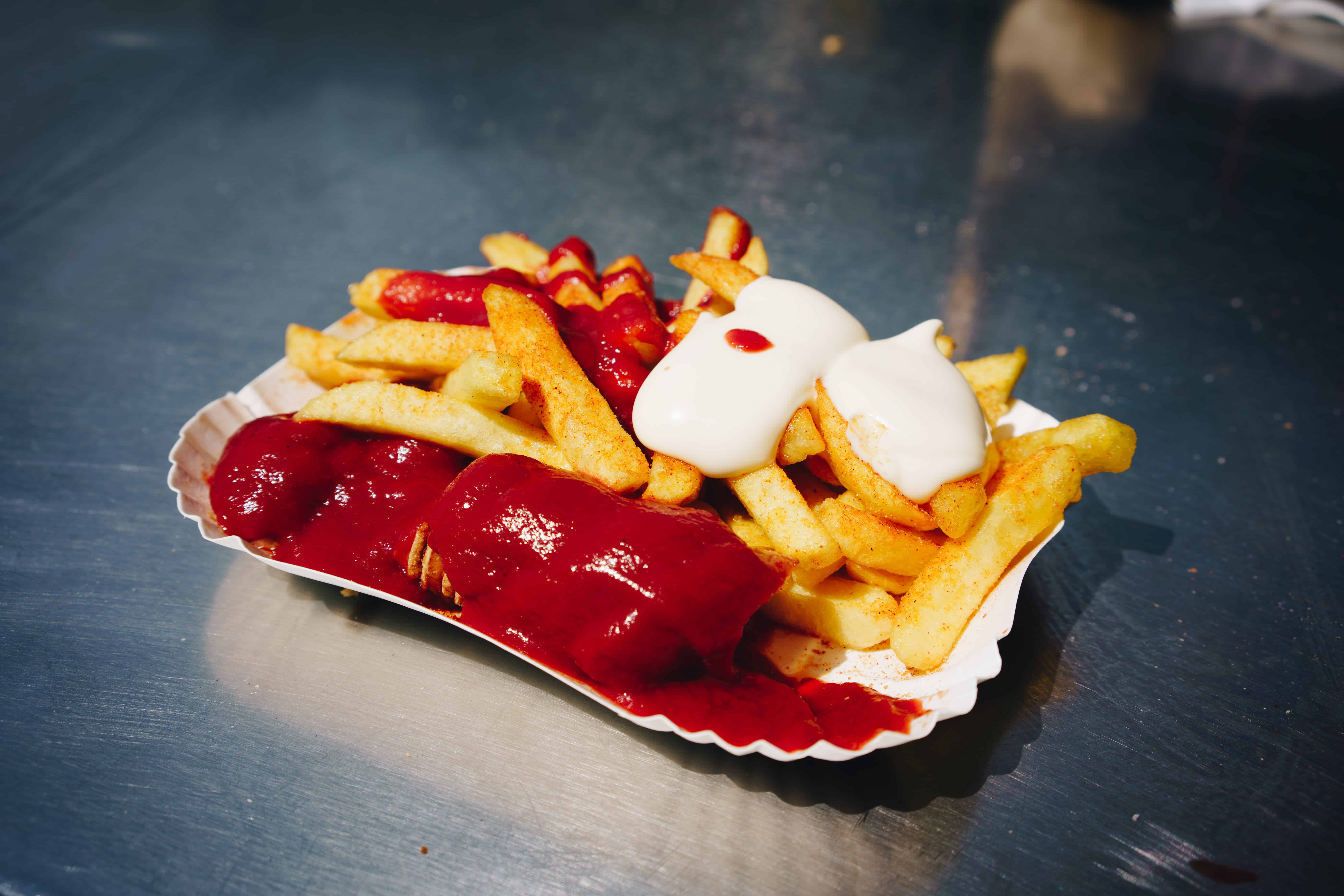
This fast food dish can be found everywhere in Germany, but it is especially popular in its hometown of Berlin.
In 1949, Herta Heuwer acquired curry powder and ketchup from British soldiers stationed in war-torn Berlin. She decided to serve a steamed and then fried pork sausage with a mixture of these two ingredients and voilà, Currywurst was born.
She began to sell it cheaply at a stand and it became popular with construction workers who were rebuilding the city. More than six decades later, Currywurst is still widely popular and often served with either a Brötchen or Pommes (french fries).
Königsberger Klopse
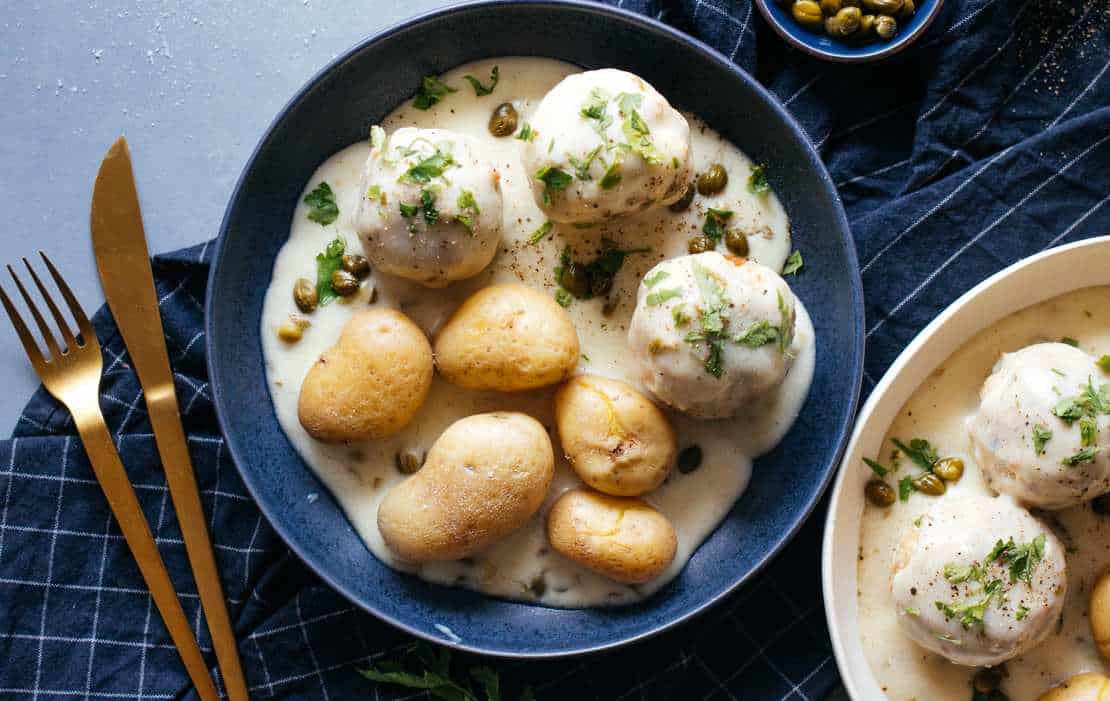
Named after the Prussian city of Königsberg (which is now known as Kaliningrad, Russia) where it was invented around 200 years ago, this dish consists of veal meatballs in a creamy white sauce made with capers and lemon juice.
It is traditionally served with boiled potatoes. The meatballs usually also contain onions, eggs, pepper, and other spices, and the traditional recipe also calls for anchovy. In the States, it is referenced as Swedish Meatballs – and be pleasantly surprised, they don’t taste anything like the dish at Ikea.
Stollen
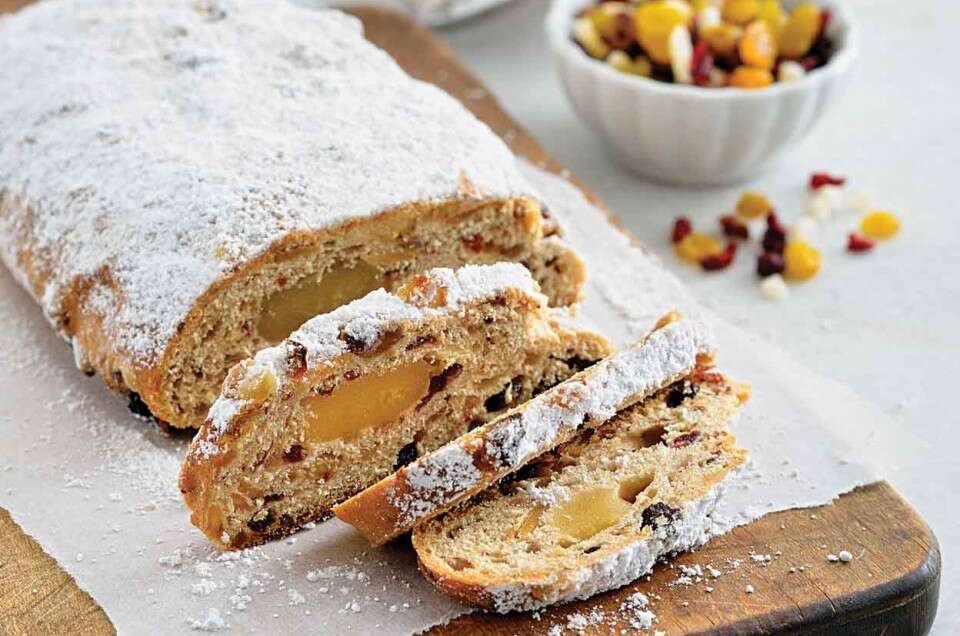
For those sugar cravings, Stollen might just be what you’re looking for. Usually eaten around Christmas time, Stollen is a bread made of dried or candied fruit, marzipan, nuts like almonds, and spices like cinnamon and cardamom.
It is usually topped with powdered sugar! The most famous Stollen originates in the city of Dresden, where the annual Stollenfest is held.
The festival takes place on the second Saturday in December, or the second Advent weekend. The city’s Stollen measures three to four tons! If you find yourself in Saxony around Christmastime someday, don’t miss out on this celebration – and eat your piece of the cake!
Prinzregententorte
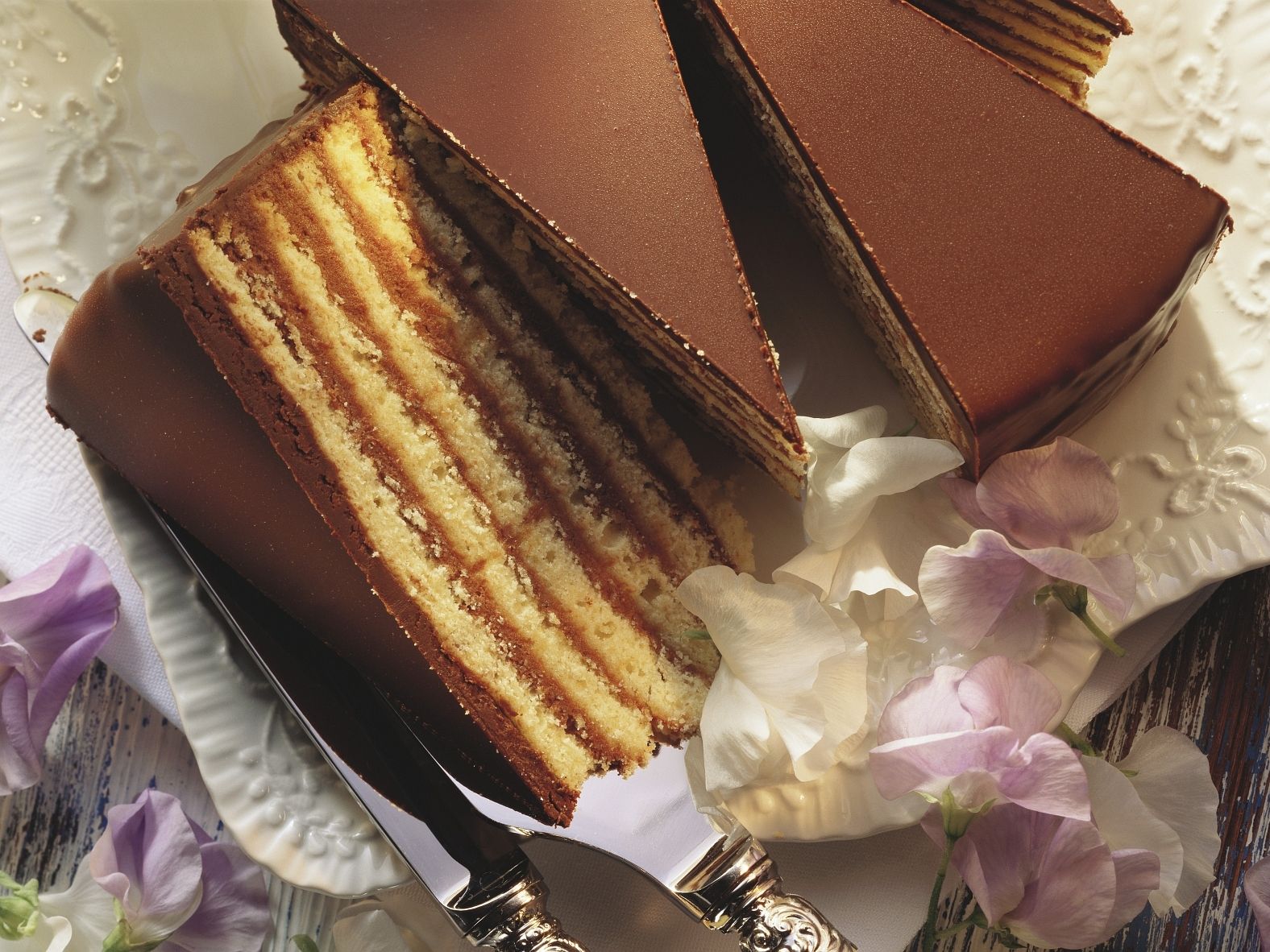
For those of you who would like something even sweeter than Stollen, the Prinzregententorte will not disappoint.
This popular Bavarian pastry is to Munich what the famous Sachertorte is to Vienna. A Prinzregententorte is a rich, multilayered cake with chocolate buttercream layers and—if that wasn’t enough—it is covered in a devilish chocolate glaze. It may also be filled with various types of creams and jams!
It is believed to be named after the Prince Regent Luitpold of Bavaria in the late 19th century.
Schnitzel
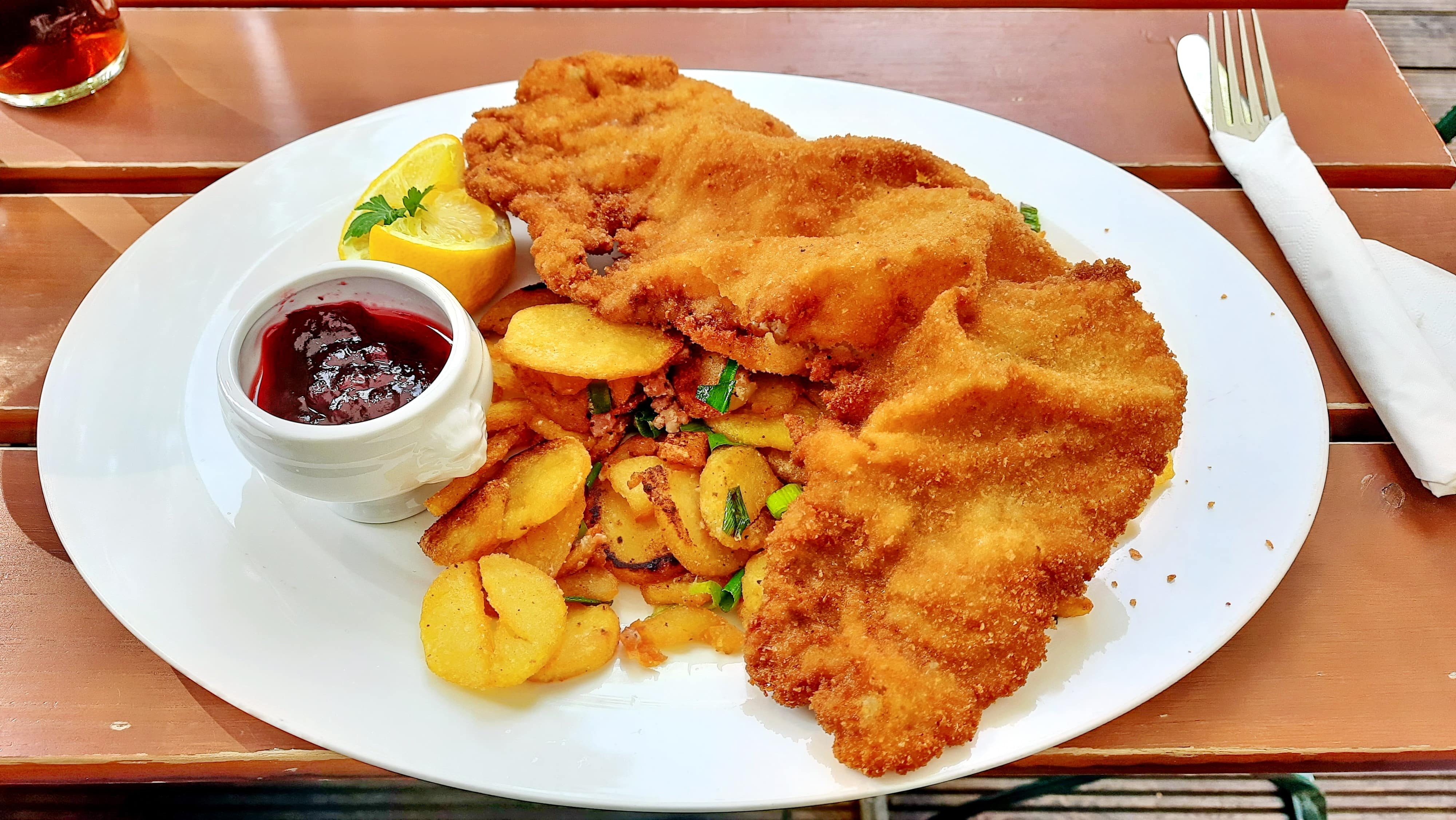
Schnitzel is a piece of pork, veal or chicken that is pounded thin, breaded and then deep-fried until it reaches a delicious golden hue. It’s often so big that it extends beyond the size of the dinner plate.
This fried-up goodness is served with a lemon wedge, some sort of berry-based sauce (like lingonberry) and some sort of potato side—French fries or potato salad.
The largest variety of schnitzel is called Wiener schnitzel, which means schnitzel in the Vienna style, which is made from veal.
Ordering Food in German
Ordering food in German is very similar to ordering food in your country, most likely. If it’s a self-service place, you walk up to the counter to order. If not, a server will come around a few minutes after you sit down.
Here are two useful phrases for ordering in German, with examples included:
Ich möchte… — I would like…
Ich möchte einen Apfelsaft. — I would like an apple juice.
Ich hätte gern… — I would like…
Ich hätte gern zwei Brötchen bitte. — I would like two bread buns please.
How to Order Food in German | FluentU German Blog
Knowing how to order food in German will help you navigate German restaurants like a native speaker. Click here to learn all the vocabulary, phrases and grammar patterns…
To pick up more food vocabulary in German (and learn common phrases for ordering!), you can practice with the video lessons on FluentU, which cover diverse everyday situations.
FluentU takes authentic videos—like music videos, movie trailers, news and inspiring talks—and turns them into personalized language learning lessons.
You can try FluentU for free for 2 weeks. Check out the website or download the iOS app or Android app.
P.S. Click here to take advantage of our current sale! (Expires at the end of this month.)
Food Culture in Germany
As in many countries, food is important in the German-speaking countries.
German Cuisine
Every German likes a hearty, traditional, home-cooked meal. Preferably some Sauerbraten (a type of pot roast), Bratwurst (German sausage) or Käsespätzle (a German noodle dish), but there’s a lot of variety between regions. Typical German food is rather heavy and often includes meat, accompanied by some side dish such as noodles, potatoes or dumplings in all forms.
While German food remains popular, we can also see a trend toward a more international cuisine. One of Germany’s favorite dishes is Spaghetti Bolognese, which is meaty but not very German. If you don’t like meat, don’t worry—you’ll be able to find vegetarian options.
For those who like it sweet, Germany’s cuisine is also filled with delicious cakes and pastries. You can also find an incredible range of chocolates, cookies and candies on the store shelves.
Meal Types and Times
Typically, Germans start their day with a nice breakfast, consisting of a bread roll or a slice of whole grain bread with ham and cheese, or butter and jam, all washed down with a strong cup of coffee. Some people prefer healthier options such as cereal with fruit.
Lunch is considered the main meal of the day. Dinner is usually a smaller, cold meal including an assortment of deli meats and sausages, cheese, German wholegrain bread and a variety of vegetables.
However, with today’s busy lifestyles many people eat their warm meals in the evening.
Many families keep traditions up by having a fancy, home-cooked German family lunch on weekends.
Etiquette
Much eating etiquette goes beyond international borders, but there are a few aspects unique to German culture.
- You don’t start eating until everyone has sat down at the table.
- You keep your elbows off the table.
- You say guten Appetit (good appetite) before you begin the meal.
- You look someone directly in the eyes when you “cheers” with your drink.
To read about German etiquette in more detail, check out this post:
German Etiquette: Customs, Norms and More | FluentU German Blog
German etiquette is as unique as the German-speaking countries themselves. To help you out, we’ve compiled a list of the most important German etiquette to be aware of,…
Feeling hungry yet?
With all these new words and phrases, you’ll be able to talk about your favorite dishes as you make them.
Download: This blog post is available as a convenient and portable PDF that you can take anywhere. Click here to get a copy. (Download)
And One More Thing...
Want to know the key to learning German effectively?
It's using the right content and tools, like FluentU has to offer! Browse hundreds of videos, take endless quizzes and master the German language faster than you've ever imagine!
Watching a fun video, but having trouble understanding it? FluentU brings native videos within reach with interactive subtitles.
You can tap on any word to look it up instantly. Every definition has examples that have been written to help you understand how the word is used. If you see an interesting word you don't know, you can add it to a vocabulary list.
And FluentU isn't just for watching videos. It's a complete platform for learning. It's designed to effectively teach you all the vocabulary from any video. Swipe left or right to see more examples of the word you're on.
The best part is that FluentU keeps track of the vocabulary that you're learning, and gives you extra practice with difficult words. It'll even remind you when it’s time to review what you’ve learned.
Start using the FluentU website on your computer or tablet or, better yet, download the FluentU app from the iTunes or Google Play store. Click here to take advantage of our current sale! (Expires at the end of this month.)

